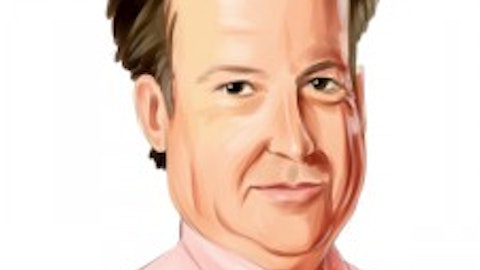Joseph Kauder: Yes, exactly. There’s a possibility that we could, given the interest in activity level that we’re seeing through the marketing of the portfolio, it’s possible that we could come out a little bit better than what the hedge has fully provided for us and so we could get a little extra capital out of it. Right now, we’re assuming the hedge is just going to cover it and so it’s going to be a wash.
Andrew Terrell: Yeah. Understood. Okay. And then another question, maybe just on the margin. And I get there’s a lot of moving pieces, but Jared, I wanted to go back to a comment you made just a minute ago about the margin would clearly be down when you immediately close the deal, but the plan would be to work it up pretty quickly thereafter with some of the balance sheet repositioning efforts. Do you have just on a pro forma basis where you think the margin kind of could shake out? Once those balance sheet actions are taken and assuming no real changes in rates.
Jared Wolff: I think that we’re going to start off below three and I think through the end of Q4, we’re going to start moving up, and we’ll be above three by the end of 2024. But that’s going to be a function of rates and a whole bunch of things. So just we’re going to start off in the upper twos and then we’ll start growing above three. Call it halfway through the year and we’ll go from there. I don’t know that I should provide you more color than that because I don’t actually know. We think we know, and we think there’s a lot of things that we can flex, but if loan yields aren’t as high, then deposit costs are probably lower too, right? So all that stuff is moving around and then it becomes a volume question. So I think hopefully that’s helpful.
Andrew Terrell: Yeah, I know. Not trying to back you into anything, just trying to spot check my model maybe. But no, that’s very helpful and I really appreciate it. Okay, that’s it for me. Thank you.
Operator: Our last question comes from David Feaster of Raymond James. Please go ahead
David Feaster: Hey, good morning, everybody.
Jared Wolff: Good morning.
David Feaster: You know, look, the timing of the closing has been incredibly fast. It’s great to see a testament to your team’s hard work. As we think about the closing of a deal this size and getting everything set in place, does essentially having a four month lead time pose any challenges for your integration team? I’m just curious, especially with all the balance sheet moves that you have, I guess, what processes and procedures I mean, you’ve got a lot of experience doing this, but I’m just curious what processes, procedures that you put in place to help ensure a seamless integration as close approaches quickly?
Jared Wolff: Well, the conversion and integration formally take place in May, so we’re closing the books and the two banks are kind of running as one, but there are things that will remain separate, and in fact, by keeping it till May, we’re substantially minimizing the risk. There was a chance we were going to do it in March, and we pushed it to May to make sure that we do it right. And so I think that’s part of the experience of the team saying, no, that’s too fast. We’re going to do it in March and we’re going to do it in May and make sure we get it right. And it’s going to cost us a little bit more, but we’re good. And so I think our teams are doing a great job working very closely together. We got a senior management committee of 25 people that’s the leadership of the combined company that’s been meeting every week.
We have a larger work stream that meets every week as well. And our teams have worked incredibly closely together, and it’s made up of a mix of people from both companies. So I think that risk is well managed. There’s risk in every deal. We actually had a third party consultant come in and look at our process on the outside and make sure there weren’t any gaps, and we got very high marks and so couldn’t be more pleased with the combined effort of the teams.
David Feaster: That’s great. And I guess as you’ve gotten deeper into this and with the deal closed, now approaching, it sounds like maybe that there’s some additional cost saves that you’ve kind of got in your back pocket. But are there any other balance sheet restructuring opportunities that you’ve identified or even just, you know, these companies really well? Is there anything that you’re maybe more excited about today with the deal than when you even initially announced it just a couple of months ago?
Jared Wolff: Well, as I said at the outset, I think PacWest did a remarkable job of repositioning their company. And Paul and his team know, and everybody at PacWest worked really hard to reposition that company under very difficult, you know, Bill Black and everybody who was involved in really trying to figure out a way to restructure that company and get assets sold, they did it in remarkable time, and that really derisked that bank. And so we’ve been through that company exhaustively. I just had an hour and a half call with their team the other day on a whole bunch of things, and I had, I don’t know, 45 or an hour call on credit. And things are what we think they are. And what we think they are is much better than other people might think that they are.
I mean, we’re looking at this and our investors know because they were in there at a very granular level. The background of the merger is clear at how long the investors were in there before we were. So I think the company is much better positioned than people see on the outside. And I’m okay with holding some of that upside for us. There’s going to be things that don’t go the way we think we’re going to go. So I’m not prepared to give away all the upside yet. I’m very comfortable, though, reaffirming our range of earnings and feel very good about it.
David Feaster: Okay, that’s terrific. And last one, just you talked about origination and kind of slowing, and it sounds like a lot of that is just strategic from your standpoint. You kind of pumping the brakes just given some of the funding challenges and the loan to deposit ratio. But I’m just curious maybe how demand is trending from your perspective? Where are you seeing good opportunities? And once the balance sheet optimization occurs and funding kind of frees up, where do you see the most immediate opportunities for you to start really driving growth?




